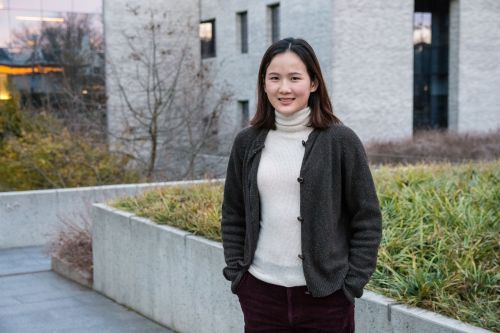
January 2022
Air flowing through a microchannel coil. Water circulating between the ocean and atmosphere. Gases exchanging to form stars throughout the galaxy. When it comes to the principles of fluid dynamics, the same simple set of equations can be used to explain them all. Yet applying these theories to understand what happens in such vastly different systems takes a lifetime.
For Jiarong Wu, the past four years have been a promising start. Ever since she was an undergraduate at Tsinghua University, Jiarong was fascinated with the theories that explain phenomena in nature. “When I started studying engineering, I realized that I was more interested in the common, basic principles behind things, more specifically the fluid dynamics that governs everything that flows,” says the fourth-year PhD student in Mechanical & Aerospace Engineering at Princeton. “From one set of equations an endless complexity emerges—it was my absolute favorite course.”
One of the most fascinating examples of these forces at play, Jiarong describes, is the ocean and how it interacts with the two largest bodies of fluids on Earth. Her work focuses on understanding how the wind amplifies the waves that cover nearly 71 percent of the Earth’s surface. While the sea is vast, Jiarong’s work takes place on a much smaller scale, examining waves of centimeters to meters in scale.
It is easy to overlook how important the wind is to the ocean system, Jiarong explains. “When you think about the driving force that keeps the waves in the ocean wavy rather than flat, it is the wind blowing. There is this small perturbation to a flat surface that gradually increases in amplitude. As the wind amplifies, it gives rise to the growth of waves,” she says.
Jiarong’s work has important applications for both weather prediction and climate change. For example, when there is a tropical cyclone, ocean wave models can predict how tall the waves will become and what coastal regions will be affected. Her research is also used for climate modeling. When waves break, they greatly enhance the gas exchange between the atmosphere and the ocean, which has a big impact on the greenhouse intake by the ocean.
This area of research is not new. For at least seventy years, researchers have studied the interaction between the ocean and atmosphere. But while the theories themselves are elegant, Jiarong says, their applicability lags far behind. As a result, she conducts numerical simulation in a “virtual wave tank” to try to analyze the flow more closely, and to bridge the gap between theories and field observations. Recently, Jiarong co-authored a paper about her research in Physics Review Fluids.
“Despite intensive scrutiny in the past century, a full understanding of the mechanism behind how wind generates wave is still missing, due to the wide range of scales involved and the nature of the problem: the coupling between the turbulent atmospheric boundary layer, the wave motion, and the turbulent water,” explains Luc Deike, PhD, assistant professor of MAE at Princeton who also serves as Jiarong’s advisor.
“Jiarong has been developing the first full three-dimensional direct numerical simulations of this problem, which will provide new insights in various wind-wave regimes. This is no small achievement and was only possible thanks to her tenacity and rigor combined with her deep understanding of the underlying mathematical background of the problem.”
Two years ago, Jiarong visited one of the most prestigious oceanography institutes: Scripps Institution of Oceanography in San Diego. The institute is home to a Floating Instrument Platform (FLIP) — a ship that rotates 90 degrees, allowing researchers to take measurements of the wind and waves at the same time. Jiarong recalls jokingly a rumor that the curtains in the conference room had to be closed because the researchers were distracted by watching the captivating waves.
Jiarong’s research experiences have enhanced her knowledge of fluid dynamics. At Tsinghua University, she studied cavitation around a bionic hydrofoil with leading-edge tubercles in a high-speed water tunnel. As a summer research intern at Duke University, she investigated signal enhancement using surface acoustic waves.
In the future, Jiarong plans to pursue a career in academia focusing on either research or teaching. “I feel really grateful to be part of Princeton and the lab I am in. I was given the freedom to explore the theoretical side of fluid dynamics,” she says.
Growing up in an urban area on the south-eastern coast of China, Jiarong was rarely near the sea. Now, it only takes an hour to drive to reach the Atlantic Ocean. While Jiarong enjoys playing beach volleyball, it can be difficult to relax near the ocean because she is always observing the waves. “Every time I see the breeze make even the smallest ripples on a puddle I think about my research,” she jokes. “There is so much pure beauty and intrigue in exploring fluid dynamics all around us.”
-- Carolyn Sayre